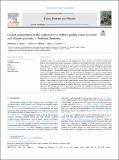| dc.description.abstract | Herbaceous vines, including the neglected crop Telfairia pedata, play a key role in small-holder livelihoods of
Eastern Africa. Despite this species’ importance in enhancing agro-biodiversity, little is known about its distri-
bution and growth performance in relation to environmental variables. We collected biophysical and environ-
mental data, i.e., on climate and elevation, for 346 T. pedata vines across four districts of Northern Tanzania from
September, 2019, to February, 2020. The four sites included Same, Lushoto, Muheza and Arumeru districts. We
found that plants of T. pedata were mainly grown in elevations ranging between 900 to 1800 m above sea level
with annual rainfall regimes of 1000 to 1400 mm. We recorded large abundance of T. pedata in Lushoto (46%)
and Arumeru (28%) and observed that the number of fruits and fruit diameter were both positively correlated
with elevation across the study districts. There was a significant effect of elevation on number of seeds, with
Same district having more seeds across the studied districts. Rainfall had a significant effect on fruit diameter and
number of seeds in the study districts. Furthermore, the tree species Albizia schimperiana was most commonly (in
40% of the cases) associated with T. pedata, followed by Persea americana (14%), and Croton macrostachyus (9%).
We highlight that mountainous regions are ideal for this highly nutritious crop, and that native trees are of high
importance for enriching this vine to current agro-ecosystems. Our findings will increase awareness on the
importance of raising T. pedata crop, livelihood diversification, and increasing biodiversity through production of
this orphan crop in small-holder farms.
1. Introduction
Telfairia pedata (Smiths ex Sim) Hook or oyster nut belongs to Cur-
cubitaceae family, which includes over 700 species and approximately
90 genera (Okoli and Mgbeogu, 1983; Odiaka et al., 2008; Chiamaka
et al., 2020). It is a herbaceous woody vine and dioecious that bears
squash-like fruits with large and nutritious oily seeds, is perennial and
can withstand drought to some extent (Onovo et al., 2010; Ifeanyi-Obi
et al., 2013), (Fig. 1). Telfairia pedata is mostly grown for its oilseeds in
Tanzania including Zanzibar Island, and other African countries
including Angola, Mozambique, coast of Kenya, Uganda and Nigeria
(Schippers, 2000; Odiaka et al., 2008; Odiaka and Odiaka, 2011; Are-
gheore, 2012). The nuts are highly valued by East Africa natives and are
in great demand by breastfeeding mothers (Fubara-Manuel et al., 2012;
Nwonuala and Obiefuna, 2015). These oilseeds are related to pumpkin
seeds (Cucurbita moschata) which are also highly important for their
therapeutic and functional (nutraceutical) values (Dotto & Chacha,
2020). Telfairia pedata nuts are mostly eaten raw or boiled, roasted for
confectionery or grounded into a thick paste for use in staple meals such
as soup thickening (Odiaka et al., 2008; Alegbejo, 2012). It contain
protein, fat, carbohydrates, oleic acid, linoleic acid, stearic acid, pal-
mitic acid, minerals including phosphorus (P), magnesium (Mg), po-
tassium (K), iron (Fe) and calcium (Ca) (Aregheore, 2007; Mwakasege
et al., 2021).
In some cases, Telfairia species provide substantial cash income to
small rural farm families and for biodiversity conservation (Akoroda,
1990; Alegbejo, 2012; Chukwurah et al., 2015). However, despite its
household income generation, nutritional and environmental value, the
cultivation of this crop in Tanzania has been neglected, and little is
known about its distribution, growth performance and constraints. The
climber grows well in presence of hard wood trees or wooden made
structures, and it is regarded as an important component of the rich
* Corresponding author.
E-mail address: shayop@nm-aist.ac.tz (P.F. Shayo).
Contents lists available at ScienceDirect
Trees, Forests and People
journal homepage: www.sciencedirect.com/journal/trees-forests-and-people
https://doi.org/10.1016/j.tfp.2022.100216
Received 30 August 2021; Received in revised form 25 January 2022; Accepted 3 February 2022 | en_US |

